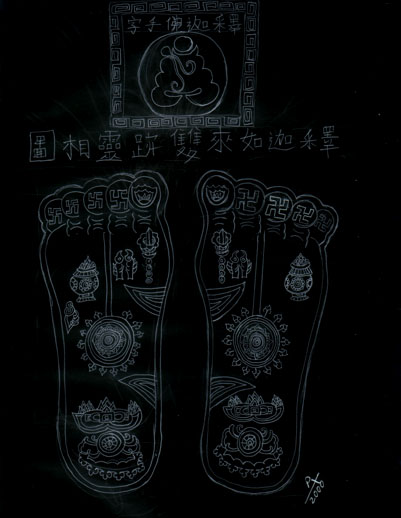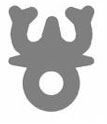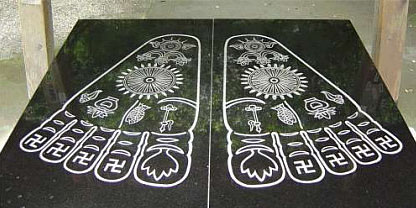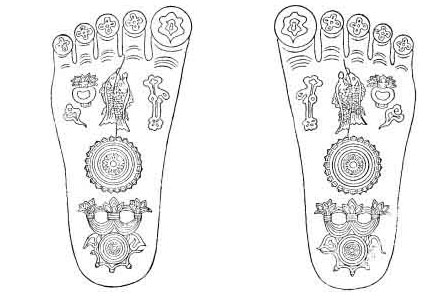COPY PAINTED BY PRISCILLA SCHIRMANN FROM A STONE IN SHAOLINTEMPLE. Shaolintemple PX/2000 |
Whoever looks upon the footprints of the Buddha "shall be freed from the bonds of error, and conducted upon the Way of Enlightenment." |
|---|
FOOTPRINTS OF THE BUDDHA IN EARLY BUDDHIST ART For four centuries after Gautama's death (approx. 483 BC), legends and facts about the Historical Buddha, his dialogues and his sayings, were preserved only in the memories of monks and followers. There were no written records or artistic representations. Like the Hindu Brahmins, the early Buddhists believed that religious knowledge was too sacred to be written down, too sacred to be etched in stone or wood. In those early years, when overt representations of the Buddha image were taboo, the main artistic vehicle for symbolizing the Buddha's presence was to show the In early examples of Indian Buddhist art, Sakyamuni is not depicted in human form; instead his presence is intimated by symbols such as the lotus, a parasol, his throne or his footprints. These footprints of early Buddhist artwork can be found throughout Asia, often in narrative reliefs depicting key episodes in the Buddha's life, and thereby indicating his personal presence. These footprints are often engraved with various Buddhist symbols. One of the most frequently used symbols in early Buddhism was the Svastikah, meaning good fortune, luck and well-being The wheel (dharma-chakra) is a symbol of the Buddha's teachings, or the Buddhist Law, as a perfect circle lacks nothing. Furthermore, the Buddha's teachings penetrate the hearts of the faithful as the wheel turns, and the act of the Buddha preaching the doctrine is called " Turning the Wheel." This wheel motif corresponds to the thousand-spoked and to the ‘Eightfold Path,' or eight rules of conduct.
We will find also another auspicious signs such as : The Flower Vase. Emblem of murô = a mystical word which might signify that condition of supreme intelligence, will triumph over birth and death. The Fish signifies freedom from all restraints. As in the water a fish moves easily in any direction, so in the Buddha-state the fully emancipated knows no restraints or obstructions. The Conch-Shell or Trumpet. It is the emblem of the preaching of the Law. The book Shin-zohu-butsu-ji-hen calls it the symbol of the voice of the Buddha. The power of the preaching and the Mâhâyâna doctrine. ====== + ====== When placed flat, the Buddha's footprint is positioned with the toes direct towards the worshippers, as if the Buddha is facing them, and when it is displayed on walls, their toes point downward. Footprints at Gokurakuji Temple (Dec. 1989) Concerning the virtue of the representation of the footprints of the Buddha, there is a text quoted from the “ Buddha-Dhyâna-Samâdhi-Sâgara-Sûtra ” : “ In that time Shaka (Sâkyamuni) lifted up his foot. . . . When the Buddha lifted up his foot all could perceive, that from beneath his feet, the Buddha radiated a light having the appearance of a wheel of a thousand spokes. And all who saw that radiance became strictly upright, and obtained the Supreme Enlightenment. " And Shaka said : “ Whosoever beholds the sign upon the sole of my foot, shall be purified from all his faults. Even he who beholds the sign after my death, shall be delivered from all the evil results of all his errors.'"
|
|---|



